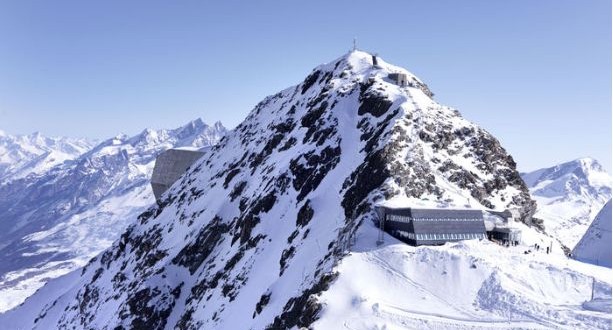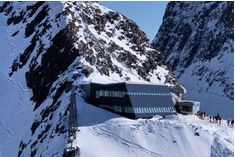The Matterhorn glacier paradise or Klein Matterhorn in Zermatt, with its viewing platform at an altitude of 3,883 meters above sea level is the sunniest place in Switzerland. What could be more natural that to utilise this environmentally freindly energy. The solar restaurant opened by Zermatt Bergbahnen AG on the south flank of the mountiain for the 2008/09 winter season produced all the electricity for heating and vetilation using the photovoltaic system built into the facade. Thanks to the optimised design, the building fulfils the requirements of teh Minergie-P standard. The energy concept is a role model for the entire Alpine region and it was therefor awarded the 2010 Solar Prize for new buildings in Zurich. For Zermatt Bergbahnen AG, however, this represents just the first step on the way to intelligent utilisation of solar energy with which to operate its infrastructure. With its groundbreaking projects, Zermatt Bergbahnen AG is continuing with the series of pioneering achievements that began in Zermatt more than 200 years ago: as early as 1767, the Geneva naturalist and first person to climb the Klein Matterhorn, Horace Benedict De Saussure, conducted the first experiments on the utilisation of solar energy here. It’s hardly surprising: with more than 2,500 hours of sunshine a year, the Matterhorn glacier paradise is the undisputed sunshine capital of Switzerland.
When developing its infrastructure, Zermatt Bergbahnen AG focuses on three pillars. The first of these is efficiency: the energy used should achieve the maximum possible effect. Renewable energies make up the second pillar and the third is the use of CO2-free electricity in buildings and to operate the facilities. This is where the solar restaurant on the Klein Matterhorn comes in. On the one hand, the building offers guests an attractive contemporary infrastructure: the ground floor of the prefabricated wooden construction is home to a shop and restaurant seating 100; on the upper floor is a room with seating for 50 and accommodation for 40 alpinists. On the other hand, its sets the benchmarks with regard to energy efficiency. At an altitude of more than 3,800 metres above sea level, the building is exposed to extreme climatic conditions. Wind speeds of up to 300 km/h and temperatures of as low as minus 30° Celsius and especially the risk of overheating due to the intensive solar radiation, presented the planners and engineers with a set of particularly tricky challenges.
The design chosen and the energy concept fulfil the stringent requirements of the Minergie-P standard. The entire electricity consumption for heating and ventilation is produced by the photovoltaic system incorporated in the facade. The ventilation at the rear of the facade is a real innovation. It prevents overheating of the solar panels while enabling the outside air used for the ventilation system to be prewarmed. At the same time, 52 centimetres of heat insulation and triple-glazed windows ensure low energy loss. With the goal of retaining all material cycles within the building to the maximum possible extent, appropriate solutions were found for dealing with the scarce resource water. The building is equipped with its own membrane reactor water treatment plant. This allows purified waste water from the kitchens and washrooms to be recycled for flushing toilets.
Every year more than half a million people from all over the world visit the Matterhorn glacier paradise. The existing infrastructure is not up to the task of handling this number of visitors. Zermatt Bergbahnen is therefore planning further developments. «The solar restaurant is a first step in the right direction on the route we intend to pursue», says Chairman of the Board of Directors Hans-Peter Julen, explaining the company’s plans for the future. «With careful design and environmentally-friendly architecture, we aim to create a place in which visitors will be able to enjoy the fantastic mountain scenery. The existing ‘tunnel and technology atmosphere’ at the mountain station of the Matterhorn glacier paradise does not meet this demand in any way. We are therefore currently in the process of investigating how we can improve the design of this viewpoint that is already attracting large visitor flows ». The findings from the construction of the solar restaurant are being incorporated directly in the planning of the largely energy self-sufficient building. First, the project outlines have to be specified more precisely. These will first be shown to the inhabitants of Zermatt before being presented to the public. Zermatt Bergbahnen AG will announce the next steps in this project in due course.


